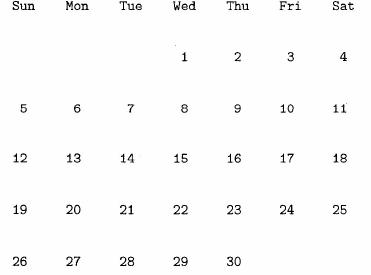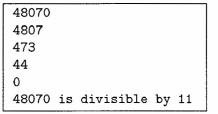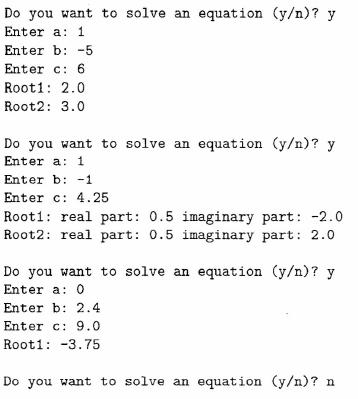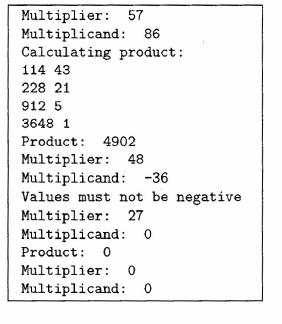Exercise 4.8
- What will be printed by each fragment?
-
for (i = 0; i <= 5; i++)
System.out.println(i*i);
n = 3;
do
System.out,println(++n);
while (n < 8); for (i = 25; i > 0; i -= 4)
System.out.println(i);
for (i, = j = 1; i < 5; i++)
{
j *= i;
System.out.println(j);
} n=26;
while (n != 1)
{
if (n % 2 0)
n /= 2;
else
n = 3 * n + 1;
System.out.println(n);
}
- Describe in a few words what would be stored in the variablevalue
afterexecution of each fragment.
for (i = value = 0; i <= 10; i++)
value += i; n = In.getlnt();
value = 0;
while (n % 2 == 0)
{
value++;
n /= 2;
}n = In.getInt 0;
value = 0;
do
{
value += n % 10;
n /= 10;
}
while (n > 0);
- A prime number is a positive integer that has exactly two distinct
divisors - one and the number itself. For example, 17 is a prime
number because it is divisible only by 1 and 17. Write a program
that reads an integer and then prints a message stating whether or
not it is a prime number.
- The number 153 has the property that it is equal to the sum of the
cubes of its digits: 13+53 +33 = 153. Write a program that will find
all the three-digit natural numbers that have this property.
- Write a program that prompts the user for a natural number and,
once one has been supplied, finds and prints all of its exact divisors.
The number 6 is said to be a perfect number because it is equal to
the sum of all its exact divisors (other than itself).
6=1+2+3
Write a program that finds and prints the three smallest perfect numbers.
- Write a program that could be used to playa simple game. The
program should first ask one user to supply a positive integer less
than 1000. Once this user has provided an appropriate value,
the program should than ask a second user to guess the number
that was given by the first user. After each incorrect guess, the
program should tell this user whether the guess was too low or
too high and ask for another guess. This should continue until
the second user has found the correct number. The program
should then print the number of guesses that the second user
needed to determine the number.
- What guessing strategy will minimize the expected number of
incorrect guesses?
Let n be a positive integer consisting of the digits dk ... dIdo. Write a
program that reads a value of n and then prints its digits in a column,
starting with do. For example, if n = 3467, then the program should
print
 - Rewrite the program in the previous question so that it prints the
digits of n in the opposite order, starting with dk and working down
to do.
Write a program that takes as input the number of days in a month
and the day of the week on which the first of the month occurs. The
program should produce a display of the calendar for that month in
standard form. For example, if there are 30 days in the month and
the first day of the month is Wednesday, the input would be 30 and
Wednesday, while the output should be similar to the following.
 - Write a program that computes the amount to which periodic deposits
of $1 will grow at a given rate of interest and for a given length of time. The program should prompt the user to provide an interest
rate as a percent (from 0 to 20) and a number of compounding periods
(from 0 to 50). The program should then produce a table with
appropriate headings showing the amount to which $1 per period
(paid at the start of each period) has grown for 1,2,3, ... ,n periods
where n is the value provided by the user. The program should reject
invalid input, continuing to prompt the user until valid data have
been provided. (Do not attempt to screen for non-numerical input.)
Amounts in the table should be rounded to the nearest cent.
Write a program that first prompts the user for a value of x, reads x
(as a double) and then computes and prints the value of eX without
using either of the methods exp or pow from the Math class. The value of ex is given by the following power series .
 In computing the value of ex, your program should continue to add
terms of the power series until it reaches a term whose absolute value
is less than 10-15 times the absolute value of the sum of the previous
terms.

The symbol n! is read as n factorial. If n is a positive integer, then Write a program that reads a positive integer and then checks to see
whether or not the integer is divisible by 11. For the divisibility test,
use the following algorithm, based on one given by the mathematician
Charles S. Dodgson (also known as Lewis Carroll).
- As long as the number has more than one digit, shorten it by
deleting the units digit and subtracting this digit from the resulting
number.
- The original number is divisible by 11 if and only if the final
number is equal to zero.
You may assume that the input is valid and that it can be stored as a
long value. Output from the program should consist of the original
number followed by any shortened numbers obtained by applying the
algorithm followed, finally, by a message stating whether or not the
original number was divisible by 11.As an example, input of 48070 should produce like the following:
 The diagram shows a unit square in the Cartesian plane and a quarter
circle of radius one, centred at the origin.

- Show that, if a point is chosen at random within the square, the
probability that it will also be inside the quarter circle is π / 4.
- Write a program that repeatedly generates the coordinates of a
random point within the square and determines whether or not
the point also lies inside the quarter circle. The program should
repeat the process 10 000 times. After every 1 000 repetitions,
it should use the results to determine and print an estimate of
the value of π (based on all repetitions up to that point).
Assuming that there are 365 days in a year and that the probability
that a person will be born on a given day is 1/365, we can calculate
the probability that, in a group of five people chosen at random, at
least two will have the same birthday, as follows:
We start by calculating the probability that all five have different
birthdays. This will be

The reasoning here is that the first person could be born on any of
365 days; the second person, to have a different birthday, could only
be born on 364 out of 365 days; the third person, to have a birthday
different from either of the first two, could only be born on 363 out of
365 days; and so on to the fifth person. Now, to find the probability
that at least two people in a randomly chosen group of five have the
same birthday, we simply subtract the above expression from 1 to
obtain.

Write a program that produces a table showing the minimum number
of people that would be required so that the probability of at least
two people in a randomly chosen group having the same birthday is
at least 0.1,0.2, ... ,0.9,1.0 - Write a program that will determine the roots of equations of the
form ax2 + bx + c = O. The program should repeatedly prompt the
user for values of a, b, and c. For each set of values, the program
should solve the corresponding equation, if it has a solution, or print
an appropriate message, if it has no solution. The program should
be able to cope with coefficients that produce either real or complex roots. It should also be able to give appropriate results if one or more of the coefficients are equal to zero. The program should be interactive. The form of the exchange between a user and a computer is shown in the following example.

- Write a program that will perform the four basic arithmetic operations
(addition, subtraction, multiplication, and division) on pairs of
fractions, producing answers in standard fractional form. Specifically,
your program should repeatedly perform the following actions.
- Read a character representing an operation. This will be one of
the characters +, -, *, i, or $. The $ signals the end of the data;
reading it should cause the program to terminate.
- Read four integers representing the numerator and denominator
of a first fraction followed by the numerator and denominator of
a second fraction.
Perform the indicated operation and print the results in the
appropriate form as illustrated in the examples that follow.
Here is an example, determining the product 57 x 86 = 4902:

Write a program that prompts the user for a multiplier and a multiplicand
and then uses the Russian Peasant Algorithm to determine
the product. Your program must also show the intermediate steps
the algorithm takes by printing out any row where an addition is required
in the first column. Your program should continue prompting
the user for input until two zeros are entered. This should terminate
the program. If a user provides negative values for either the multiplier
or the multiplicand, these should be rejected. If one value is
zero and the other is positive, the program should give the correct
result without using the algorithm. Using the example above, your
program should function as shown in the following sample:
 |
|